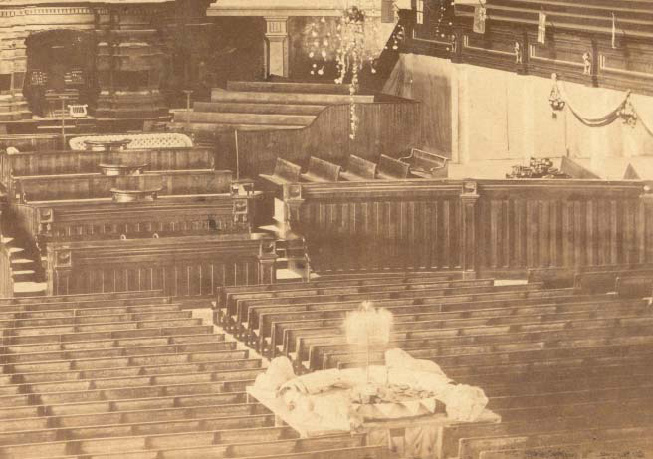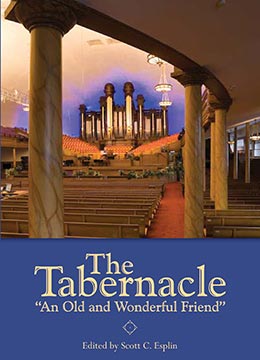Later Additions to the Tabernacle
Scott C. Esplin, “Later Additions to the Tabernacle,” in The Tabernacle: “An Old and Wonderful Friend” (Provo, UT: Religious Studies Center, Brigham Young University, 2007), 249–52.
There have been many improvements and refinements in the Tabernacle since it was dedicated. At the time of its completion, there was no provision made for either heat or light. Thus the usefulness of the Tabernacle was restricted to the daylight hours and warm weather. It was not until 1884 that a heating and lighting system was installed. The Salt Lake Daily Herald greeted the achievement with an editorial in its issue of April 1, 1884:
The Tabernacle was illuminated by gas last evening, for the first time, and the effect was grand and satisfactory in every respect. The 300 jets filled the immense hall with light, illuminating every part of the auditorium. The steam was also turned on and in a short time the place was quite warm, suggesting the propriety of the ladies bringing fans to the concert this evening. The lighting and heating may both be considered successes, and the wonder is that the improvement was not made years ago.[1]
The gas line was run around the front of the gallery, and the jets were supported by arms extending from the face of the gallery.
The gas was gradually replaced by electricity, although the conversion was not made all at once. An early picture of the interior of the Tabernacle, which the author was unable to get copied, shows the gas jets around the front of the gallery and one lone electric light hanging from the ceiling. It looked like a primitive version of modern electric lights. It was probably being used as a test to determine the feasibility of lighting the Tabernacle with electricity.
One of the most unusual refinements in the early days of the Tabernacle was an interesting cooling system that was installed. It consisted of a large fountain erected in the front center portion of the building, completely blocking the center aisle. Several persons to whom the author talked remembered the fountain and stated that it was left in for a number of years. Mr. LeRoi C. Snow, a member of the Church Historian’s staff, related an amusing story in connection with the fountain:
It seems that at one June conference, when the Tabernacle was very warm, a family of good Saints from Hawaii was in attendance. They had entered the Tabernacle from a front side door and were attempting to make their way down the center aisle to find seats. To do so they had to detour around the fountain, for which purpose steps and a walkway were provided. One of the youngsters of the family, on coming abreast of the fountain fell a victim of temptation and eagerly dived in, and began a vigorous splashing. He was duly extricated, much to the amusement and probably the envy of the assembled Saints.
Another feature of the Tabernacle was the giant canvas curtain that was hung directly across the center of the building, thereby cutting the auditorium in half and limiting the usable space in the Tabernacle to the front, or western half, of the building. This was found to provide adequate space for the usual Sabbath meetings, and only at conference and on other prominent occasions was the curtain lifted and the whole hall used.
The speaker’s stand and the choir loft have been remodeled at least three times with many minor modifications as needed. The major stand changes were made at the time of the rebuilding of the organ. A radio control booth has been installed under the end of the gallery and immediately adjoining the stand on the southwest side of the building.
There have been at least three changes of roof surfacing and many repair jobs. The original roof was wood shingles and patent roofing. This was replaced by a metal roof constructed of metal shingles about sixteen inches square. Another major overhaul of the Tabernacle progressed during the summer of 1947. A completely new aluminum roof was put on the huge dome of the building. This roof was made to the specifications of the Tabernacle. The building was painted inside and out with the exception of the seats. Dr. Wayne B. Hales, whose acoustical study of the Tabernacle was quoted previously, told the author that the painting of the ceiling of the Tabernacle in 1947 resulted in a longer reverberation period. This may have a slight effect on the acoustics of the building but probably will not be noticeable to the layman. The Tabernacle now reflects the bright sunlight from its shiny new roof, and it presents a startling picture as one catches a glimpse of it through the trees as he descends Salt Lake City’s Main Street from the north.
As modern technology improves, additional changes will be made in the Tabernacle. But like the others, they will probably be minor and leave the major portions of the Tabernacle intact. So great is the pride of the Mormon people in their historic Tabernacle that it is unlikely that any major change will be made which might affect its remarkable acoustics or otherwise impair its usability.
 The Tabernacle had a fountain, which helped cool the room, flowing in the middle of the seating area from 1875 to about the mid-1880s. It as flanked by four lion statues, visible on each corner. It was eventually dismantled, and some of the lions may have been used later to decorate the Tabernacle.
The Tabernacle had a fountain, which helped cool the room, flowing in the middle of the seating area from 1875 to about the mid-1880s. It as flanked by four lion statues, visible on each corner. It was eventually dismantled, and some of the lions may have been used later to decorate the Tabernacle.
Notes
[1] “All Ready,” Salt Lake Daily Herald, April 1, 1884.
